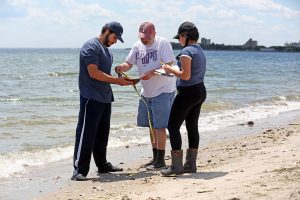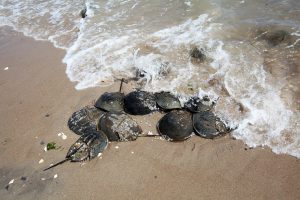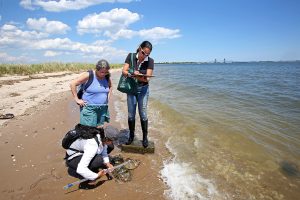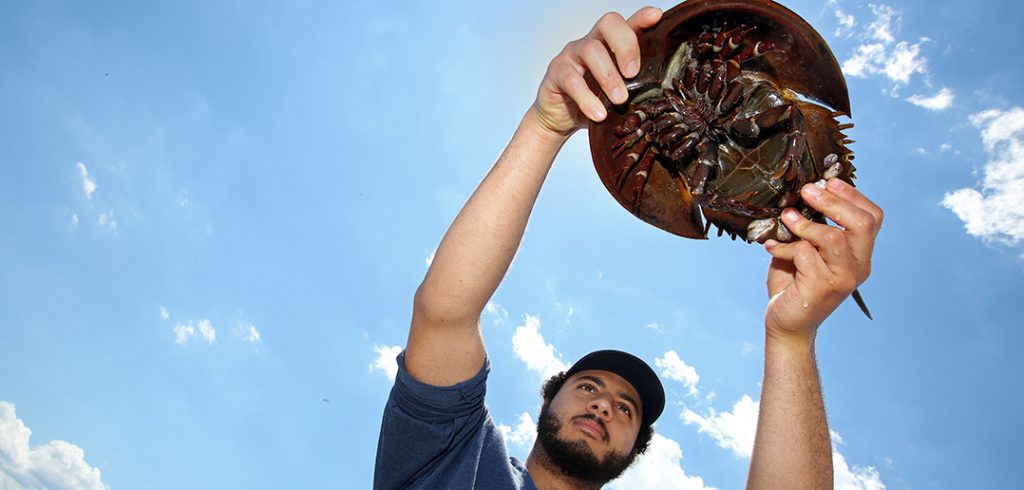Plum Beach, a spit of land sandwiched between Jamaica Bay and the Belt Parkway in Brooklyn, will never be mistaken for Coney Island or the Rockaways. Its amenities are few, there is no access to mass transportation, and the sand is littered with untold detritus from the sea.
It’s also heaven for Limulus polyphemus, aka the Atlantic horseshoe crab.

On a recent afternoon at high tide, three teams of researchers led by Fordham biology professor Mark Botton, Ph.D., waded into the waters of the bay and methodically plucked one of the oldest animal species in the world from the surf. Armed with measuring tape, calipers, and notebooks, they recorded data such as the size of the crab’s carapace, its sex, and whether it had seaweed, barnacles, or slipper shells on it.
The crabs had come to the beach to mate, just as they have been doing for an estimated 450 million years. Clumps of as many as a dozen crabs crowded around each other, occasionally flipping over when a high wave swept in.
Botton, who grew up in nearby Midwood, has been coming to Plum Beach since 2011, shortly after the south side of the beach was replenished to alleviate severe erosion. The north side, which is slightly more protected from the Atlantic Ocean, was never rebuilt, and as such, it is where the crabs gather. Since global warming is expected to cause seas to rise in the future, Botton said beach replenishment projects will become more common.
“All things being equal, if you have a choice of what kind of sand to put on the beach, it makes a difference for the crabs. We’d like to be able to inform future policy, because if you’re going to do it, you might as well do it in a way that provides a maximum benefit for wildlife, as well as people,” he said.

Horseshoe crabs play a vital part in the ecosystem as predators of small fish and mollusks, and also as prey for migrating shore birds that feast on their eggs. Their blood is also used by pharmaceutical companies to test cancer drugs.
Karine Khoder, a rising Fordham College at Lincoln Center (FCLC) senior from Bay Ridge who is concentrating on organismal biology with the goal of attending medical school, also said that their fearsome appearance belies the fact that they’re utterly harmless to humans.
“You can stick your fingers all up in their claws, and they won’t do anything; they’re not strong enough to hurt you,” she said.
“It’s cool to see the crabs are relatively the same as they were hundreds of millions of years ago. I think that’s impressive. They’re doing something right.”
Khoder accompanied Botton, along with fellow FCLC classmate Adam Aly, who grew up in Flushing, Queens, and became familiar with the crabs when he worked as a lifeguard in the Rockaways. Like Khoder, he hopes the research he’s conducting on the crabs this summer will help him gain admission to medical school.

Christina Colon, FCRH 99, assistant professor of biology at Kingsborough Community College, also brought several students for the count.
“It’s not just the crabs. Students see migratory birds they’ve never seen before, sharks, sea turtles, stingrays—these are things that they don’t get to see firsthand,” she said.
“It changes the way they look at New York, the way they look at nature, and the way they look at their ability to do real science.”
After a few hours of counting, the three teams dug into the sand to harvest some eggs. They evaluated 300 crabs in total, and, as expected, they encountered roughly four males for every female. That’s because females, which are larger, tend to burrow into the sand, release eggs, and then depart, while the smaller males visit the shore at every high tide.
The population of Limulus polyphemus is healthy in this part of the country, said Botton, but they’re still a great research focus.
“To have science students develop a small project on their own that they can take ownership of, and take pride in, is a really important part of the learning experience at Fordham,” he said.
“We want to encourage them to get involved in research, and understand that it isn’t just performing a cookbook recipe out of a lab manual. At some point, you have to sit down and think about ‘what would I like to demonstrate, and how can I test this hypothesis, get data, work with the data, and eventually give a presentation.’”
[doptg id=”89″]


